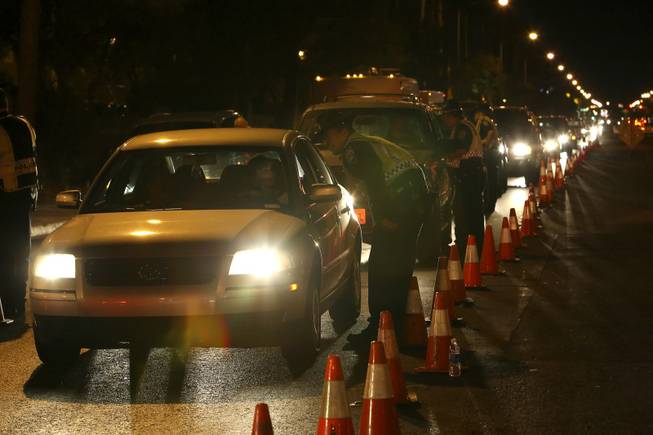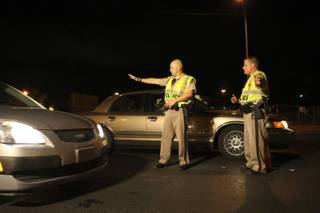
Mona Shield Payne / Special to the Sun
Nevada Highway Patrol troopers conduct cursory inspections while looking for impaired drivers Saturday evening at a DUI checkpoint on Rainbow Boulevard north of Cheyenne Avenue.
Monday, Aug. 24, 2009 | 2:05 a.m.
In the 30 years since the fight against driving under the influence of alcohol began, a lot has changed and the number of drunken drivers has decreased. But some new trends are beginning to worry experts.
For Gary Urbantke, the fight against impaired drivers has been personal for 25 years.
Urbantke, once a Henderson police officer, was driving from Las Vegas to Henderson to pick his daughter up from school on July 16, 1984.
His wife and 5-year-old son were with him in the car when he saw a van coming straight at him — in his lane on the divided Boulder Highway near Russell Road.
The two cars collided at a combined speed of more than 100 mph.
Urbantke was knocked out and paralyzed. His wife was killed instantly and his son died four hours later at a hospital.
The other driver had only a broken leg. He was arrested, convicted and served 10 years in prison for the crash — two years less than the maximum allowed at the time for two counts of felony DUI.
Urbantke has since remarried and gone on with his life.
“But there isn’t a day goes by that I don’t think of both my wife and son, and it’s the same way for my daughter,” he said. “It’s something that will affect us for the rest of our lives.”
“We were fortunate in the fact that this man was tried, he was convicted and he did his time; a lot of people get off on technicalities.”
Urbantke has been lobbying for tougher DUI laws and has been trying to educate people about the dangers of impaired driving.
Since the crash, DUI laws across the nation and in Nevada have become stricter, with harsher penalties and lower blood-alcohol levels permitted.
But alcohol-related crashes still accounted for about 37 percent of Nevada traffic fatalities in 2008, a figure that has stayed virtually unchanged for more than a decade.
As an annual national campaign against driving under the influence kicked off Friday, two trends are particularly worrisome to law enforcement officials — the rise in people driving under the influence of drugs and the increase in the number of women driving under the influence.
--
The National Highway Traffic Safety Administration organizes the annual crackdown on impaired driving to coincide with Labor Day. This year’s campaign began Friday and concludes Sept. 7.
It includes DUI checkpoints and $13 million in nationwide advertising to remind drivers that if they're under the influence, they will be arrested if caught.
“Drugged drivers, teens and impaired female drivers are the focus this Labor Day,” said Nevada Highway Patrol Sgt. Kevin Honea in a statement. “So much of our outreach centers on men under the influence of alcohol, but we can’t forget that impaired driving cuts across all segments of society.”
Southern Nevada law enforcement agencies also will be on the lookout for impaired drivers. Metro conducted a DUI checkpoint Saturday night near the intersection of Cheyenne Avenue and Rainbow Boulevard.
Metro says these types of events are part of stepped-up enforcement that has led to an increased number of arrests for impaired driving.
In 2003, Metro arrested 3,469 people on charges of driving under the influence. In 2007, that number jumped to 8,495.
During the same period, the number of DUI arrests nationwide decreased 1.4 percent.
While some of the increase was due to population growth — Clark County’s population jumped 14 percent during that time — Metro also credits its enforcement.
“Our last two sheriffs have said we’re going to put a stop to this,” Metro spokesman Bill Cassell said.
Metro accident investigator Bill Redfairn said Sheriff Doug Gillespie, as well as his predecessor, Bill Young, helped to make a difference.
Gillespie has “made a commitment, put resources into that, has increased the number of motor officers we’ve got and that gives us the opportunity to do more DUI enforcement,” Redfairn said.
--
One morning last July, Patricia Hoff and Porsche Hughes were sitting at a bus stop on Boulder Highway when Steven Murray drove into them, killing Hoff and seriously injuring Hughes.
Investigators later determined Murray was under the influence of the prescription drugs Percocet and Valium.
Murray was convicted of causing a death while under the influence of a controlled substance and of driving under the influence of a controlled substance resulting in an accident with fatality or bodily harm.
“It’s impacted every day in my life. I don’t have my mom there,” Hoff’s daughter Robin Wynkoop said recently.
The Murray case exemplifies what local and national authorities say is a growing trend of driving under the influence of drugs — both prescription and illicit.
“Over the years, we’ve seen an increase in the number of drugged drivers on our roads and highways commensurate with the substance abuse problems we have in our communities, including not only illicit drugs but prescription narcotics,” said Nevada Department of Public Safety Director Jerry Hafen at a news conference last week in Las Vegas.
In Nevada, 81 of the 187 deaths caused by impaired drivers in 2006 involved drugs, according to data from the National Highway Traffic Safety Administration.
While 33 of those deaths were from drivers who had used a combination of drugs and alcohol, 48 of the drivers had only drugs in their system.
Driving under the influence of drugs is included in the state’s DUI laws, and having a prescription for the drugs is not an accepted defense, said Bruce Nelson, a deputy district attorney with the vehicular crimes unit.
A Las Vegas Sun analysis of prescription narcotic consumption across the country between 1997 and 2006 revealed that Nevadans consume about twice the national average per capita of prescription narcotics.
In a nationwide study performed by the National Highway Traffic Safety Administration, more than 16 percent of tested drivers were under the influence of drugs.
While that doesn't mean all of those drivers were impaired, more than 11 percent of the drivers in the survey tested positive for illicit drugs, five times as many as those who tested positive for alcohol.
“This should be a national wake-up call,” Gil Kerlikowske, director of the White House Office of National Drug Control Policy, said at the Las Vegas news conference last week. “Given the impact and the success that we’ve had ... on alcohol-impaired driving, we should be able to devote the same level of attention and resources (to drugged driving).”
--
While the number of men charged with impaired driving dropped more than 14 percent nationwide from 2003 to 2007, the number of women arrested on DUI charges during that time increased 4.6 percent, according to data from the FBI. During the 10-year period that ended in 2007, the number of women charged with impaired driving increased nearly 30 percent, according to the same data.
In Las Vegas, the gender split has remained stable since 2002, when Metro first began tracking the gender of DUI arrests.
Since then, women have accounted for about 19 percent of the total DUI arrests each year. In 2003, Metro arrested 682 women for impaired driving, 19.6 of the total 3,469 arrests. In 2008, 1,551 women were arrested, about 18 percent of the 8,495 total.
While Metro’s numbers haven’t changed much, Nevada was one of 10 states identified by the National Highway Traffic Safety Administration with an increase in the number of female alcohol-impaired drivers in fatal crashes last year, putting it on the priority list for this year’s DUI campaign.
Nelson also said he has seen an uptick in the severity of the cases that come across his desk at the District Attorney’s office.
“Some of our most serious — that is, highest alcohol level — drunk drivers have been women,” he said.
A case in recent weeks involved a woman whose blood alcohol level was .46, he said. The legal limit for blood alcohol is .08 percent.
“That should have killed her, but it didn’t,” Nelson said.
Part of the problem with an increase in women driving under the influence is that women are more likely to have children in the car, according to the administration’s data.
In February, 28-year-old Amanda Werber was driving 100 mph on U.S. 93 in Boulder City when she rear-ended another car, causing that car to flip and injuring two people.
Werber and her 18-month-old child, who was in the car with her, were not injured. She was charged with driving under the influence, reckless driving and child endangerment.
After pleading guilty to reckless driving resulting in bodily harm and child endangerment last Tuesday, Werber is scheduled to be sentenced in November.
According to the National Highway Traffic Safety Administration study, about 35 percent of the alcohol-impaired female drivers had passengers with them.
Sandy Heverly, executive director of STOP DUI, said she has seen the effect that parents have on their children when they drive under the influence.
She was speaking at a junior high school when a girl asked if she should avoid riding in the car with her parents after they drink wine at dinner.
“I was just stunned by that (question),” she said. “And hand after hand after hand went up of kids that were put in that situation. And so I went from junior high to junior high to junior high and, oh my gosh, it was unbelievable because the majority of the kids in those classes were telling me that they were subjected to that type of a situation.”
For children who are in the car when a parent is arrested for driving under the influence, the experience can be traumatic, Heverly said.
If a parent is arrested for drunk driving and no other responsible adult can immediately be reached, the children are usually taken to Child Haven, the county’s emergency shelter for abused and neglected children.
The law does provide for stricter penalties for those who drive under the influence with children under the age of 15 in the car, Nelson said. And drivers with children in the car can be charged with child endangerment, a gross misdemeanor.


Join the Discussion:
Check this out for a full explanation of our conversion to the LiveFyre commenting system and instructions on how to sign up for an account.
Full comments policy